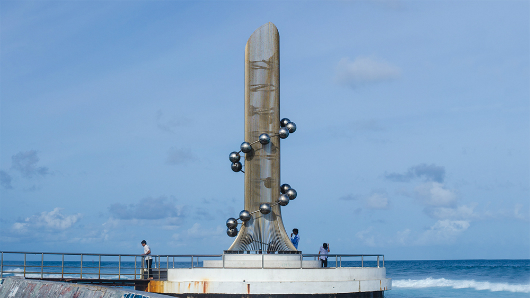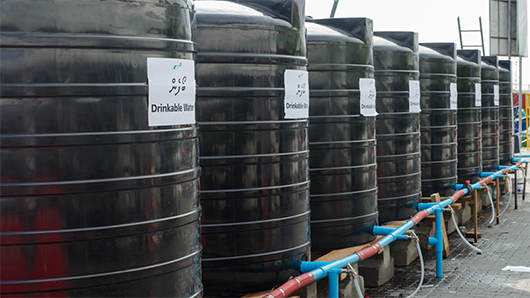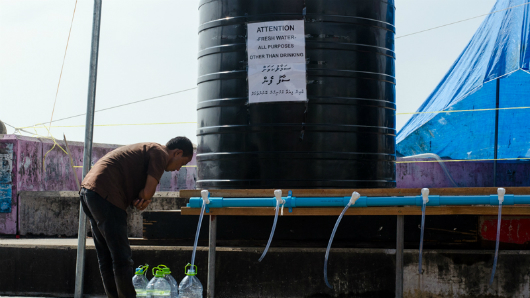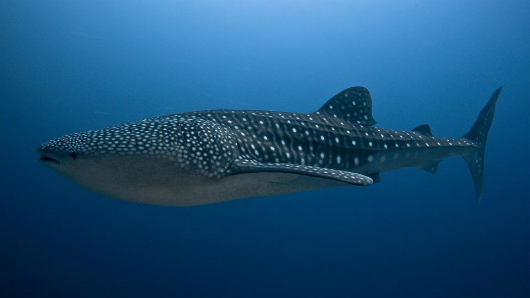“[T]here is no doubt about it, the Maldives has to be one of the most beautiful, colourful – and sometimes complicated – places on the planet,” concludes British travel writer Tom Chesshyre at the end of his journey around the ‘real’ Maldives.
Gatecrashing Paradise: Misadventures in the Real Maldives – officially launched this month but already available online – makes a notable contribution to Maldivian travel literature, detailing the writer’s trip around the country’s inhabited islands.
“I had heard of a change in Maldivian law that allowed visitors to travel off the beaten track to islands that were not official tourist islands,” writes Chesshyre.
“A whole new country had effectively opened up, hundreds of islands seldom seen by outsiders. It’s not all that often something like this happens in the twenty-first century.”
Taking in the length and breadth of the atolls, the journey around the “edges of perfection” is described as “blissful, troubled, joyous, delicious, fraught, and always very, very watery.”
Along the way – via a host of colourful characters, Chesshyre is introduced to the reality and the frustrations of the Indian Ocean nation known best for its 109 single island luxury resorts.
Anticipating greater concern about climate change – with which the country has also become synonymous – the author learns about the issues that affect the everyday lives of Maldivians and expatriate labourers, including the country’s “surprisingly turbulent” political scene.
Listing his first hand discoveries as including human rights abuses, rigged elections, human trafficking, corruption, hard drug use, fundamentalism, high divorce rates, an “overactive” secret police, the huge division between tourist and locals, and the maltreatment of resort workers, the author is left dizzy.
“Go to just about any country and there are ‘issues’, but the Maldives was almost flamboyantly (and unexpectedly) alive with controversy of one sort or another,” writes Chesshyre.
The journey
Arriving in the capital Malé – which strikes the author as a ‘mini-Manhattan’ dropped into the ocean, he hitches a cargo ship to take him 330 miles south to Addu.
Past the equator, he gathers a sense of the country’s history, visiting the old RAF base in Gan – closed in 1976, learning about the United Suvadive Republic, and visiting the graveyard in Hulhu-meedhoo – regarded by many as being the oldest in the country.
Locals describe the lasting impact the British had on them, while RAF veterans holidaying in the Equator Village give insight into the effect Gan had on the British – as does a grainy 1970s documentary.
‘It can produce in the most level-headed men, a profound claustrophobia … at the beginning of the stay on Gan it is not unheard of for men to weep at the sheer geographical isolation,’ explained the video’s narrator.
Similar comments the author received from a Bangladeshi worker in the atoll – ‘I don’t like it here…In four to five months I go home’ – reflected the feelings of most of the foreign labourers encountered during the adventure – overworked, underpaid, and trafficked.
After pole and line fishing – and time spent observing police kept too busy by the local drug trade to worry about climate change – the journey heads north, taking in the ancient Bhuddist stupa in Isdhoo and shedding light on the country’s complex relationship with its past.
A visit to Vilufushi brings home the reality of the 2004 tsunami and the country’s vulnerability to the ocean, with the writer enjoying the hospitality of former refugees glad to be back home after an enforced stay on the nearby island of Buruni.
“Strip everything away (every penny, all your possessions), wash it into the sea and find yourself sent to a refugee camp for a few years: I wondered how we would deal with that back home. Would we be quite so calm and welcoming?” he ponders.
A return to Malé, and Hulhumalé – described as ‘emergency island’ due to its 2 metre height – is followed by a briefing on the media climate in the country from representatives of Minivan News.
After hearing of the abduction of Minivan News journalist Ahmed Rilwan during the final editing stages of the book’s production, the author will be using promotional events in the UK to publicise the case.
Finally, a trip to the country’s far north reveals the mythology that defines much of the nation’s identity. Visiting the home of Mohamed Thakurufaanu in Utheemu, the author brings the tales of the independence hero to a new audience.
Chesshyre then journeys to the Maldives Climate Observatory in Hanimaadhoo, which monitor levels of ‘Atmospheric Brown Cloud’. Despite the apparent ambivalence of those nearby, the observatory in Hanimaadhoo continuously beams a steady stream of alarming evidence of global warming to NASA.
The politics
Heading back south, the book delves into the country’s murky political waters: “If I was going to be gatecrashing paradise, I did not want to paint over the cracks.”
Chesshyre describes an interview with former President Dr Mohamed Waheed’s brother Naushad (conducted in London before the trip), who pales when recalling the torture he suffered under the dictatorship.
‘It’s not just me that they tortured. It was all of us in prison. They do that, you know, for their own pleasure. They are sick men…,’ Naushad explains.
More time in Malé brings the author into contact with Maldivian Democratic Party activists in election campaign mode, bringing the firm realisation that tourism and politics in the Maldives have become inseparable: “bound together tightly with knots that were difficult to unpick”.
Chesshyre’s exploration of the country’s politics culminates in a rare interview with former President Maumoon Abdul Gayoom.
In a cagey encounter, the 30-year leader suggests the opposition had manipulated a ‘gross misrepresentation’ of his regime’s human rights record, describing the case of Evan Naseem’s murder in police custody in 2003 as an ‘isolated incident’.
That a travel book about the Maldives’ guest house tourism is not complete without a journey into the country’s politics may explain the reluctance of many within the industry to fully embrace mid-market tourism.
But the book clearly depicts a guest house scene largely undiscovered (in 2013), which offers the chance to experience the warm communities and rich culture of island-life. Such luxuries are inaccessible on even the most expensive resort – as is the opportunity to develop a taste for garudiya (as the author does).
“Away from the golf buggies, spa treatments and infinity pools of holiday- brochure paradise, I was discovering a parallel existence in which courtesy, good manners, gentleness and civility came to the fore,” explains Chesshyre.
The key to ‘gatecrashing’ the lesser-known parts of the archipelago, however, are realised soon after Chesshyre’s arrival – once the immediate desire to bolt for the clichéd tranquility of a resort had subsided.
“I would simply have to get used to the unspoken rules in the Indian Ocean, which appeared to be: take it easy, my friend, or else you’ll never understand us.”





